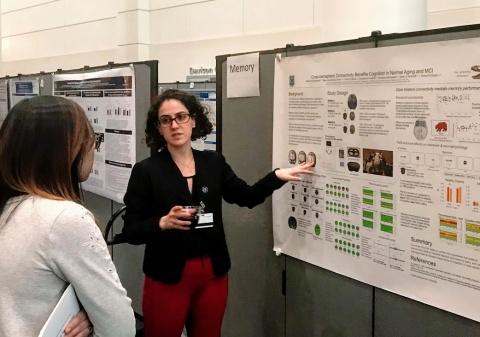
The Duke Neurology Department’s clinical, translational, and basic science wings came together last Thursday to discuss their work and collaborate at the Division of Translational Brain Sciences and Neurology Residents first joint poster session.
Research faculty, postdoctoral associates, clinical neurology residents, and other members of the Department presented more than 30 ongoing research projects from a variety of disciplines and perspectives.
Chief Resident Abhi Kapuria, MD, gave a short presentation on a pilot project using augmented reality to improve epilepsy surgery; Assistant Professor Simon Davis, PhD, discussed his ongoing research using transcranial magnetic stimulation to analyze how networks within the brain change over the lifespan.
Other projects examined repurposing a medication developed for HIV for use in dystonia, how mutations in the SNCA gene affect nuclear function in Parkinson’s disease, and enhancing neural progenitor cell migration after stroke.
“The poster session was the first step towards building a strong collaborative community among the research faculty in our new division of Translational Brain Sciences and the clinical side of the Department,” said Ornit Chiba-Falek, PhD, Chief of the Department’s new Division of Translational Brain Sciences. “By working together, our basic and translational scientists, and our clinicians will bring greater success to our Department, with the whole much greater than the sum of its parts.”
Chiba-Falek hopes to build on the success of this event by making the session an ongoing biannual event. The next session is scheduled for this October.
The full list of the posters at the session is as follows:
- Fit-for-Purpose Quantitative LC-MS and CE-MS Metabolomics Methods to Inform Alzheimer’s Research
- Accelerating Brain MR Imaging for Small Animal Models
- Phenotyping Sex Dependent Glial-specific Changes In The Chromatin Accessibility Landscape In Late-onset Alzheimer’s Disease Brains
- Repurposing the HIV Protease Inhibitor, Ritonavir, for DYT-TOR1A Dystonia
- The Mechanistic Role of Alpha-Synuclein in the Nucleus: Familial Parkinson’s Disease SNCA Mutations Impair Nuclear Function
- Laser capture microscopy in autopsy brain samples from humans with AD
- Synchronized Transcriptional Control of Autophagy and Inflammation across Neurodegenerative Diseases
- Interpretable Model-Based Phonetic Selectivity Using High-Density µECoG Engineering Angiogenic Biomaterial for Brain Repair After Stroke
- Sustained Activation of the DNA damage Response to Double-Strand Breaks in LRRK2 G2019S Parkinson’s Disease
- Biological Effects of Overexpression of The Mitochondrial Protein Import Channel Tom40
- The Biological Underpinnings of TOMM40 Risk Factor for AD Profiling SNCA Intron 1
- Methylation in Post-Mortem Human Brain Tissues Using Fluorescent Activated Nuclei Sorting (FANS)
- SRCP1 utilizes Functional Amyloid to Suppress Polyglutamine Aggregation
- Striatal Cholinergic Interneurons Require Tonic Activation of Stress Response Pathway to Maintain Integrity of Dopamine Signaling and Behavior: Significance for DYT1 Dystonia
- Cross-hemispheric Connectivity Benefits Cognition in Normal Aging and MCI Strokes in LVADs
- Augmented Reality in Epilepsy Surgery
- Use of a Genetically-based Biomarker Risk Algorithm to Design Alzheimer’s Disease Clinical Trials With Outcomes Based on Neurocognitive Measures
- Shared Genetic Etiology Underlying Alzheimer’s Disease and Major Depressive Disorder
- Visualizing Normal EEG Variants via Source Localization Technique Complete Spatial Resolution of Brain N-Glycans: Focus on Modulation in Parkinsonism
- Acute Onset of Chorea as the Presenting Symptom of SLE Using hiPSC-derived Neurons & Astrocytes to model the role of APOE in Late Onset Alzheimer’s Disease (LOAD) in the context of aging
- An Isogenic hiPSC-derived Model System for Establishing Gene Therapy Approaches in Alzheimer’s Disease
- Enhancing Neural Progenitor Cell Migration after Stroke
- Not Yet Determined Sex Dependent Glial-specific Changes In The Chromatin
- Accessibility Landscape In Late-onset Alzheimer’s Disease Brains